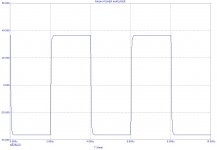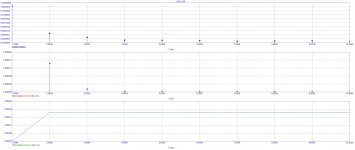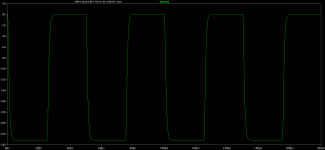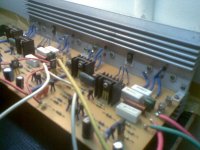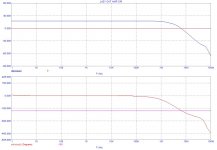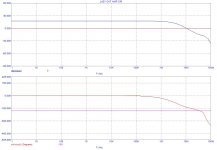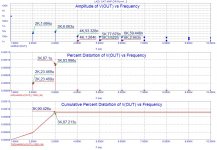And the harmonic distribution, each harmonics contribution as % and THD as %. Of course these are all simulations. My amps are transparent subjectively speaking. Simulating with your front end configuration did change the harmonic distribution as well as THD marginally in the simulation but the ear would not detect it as it is virtually non existent.
I have listened again and again switching between the two configurations on headphones after I have adjusted each config to output the exact same amplitude. Now I must admit that I am convinced that in my first testing claiming a different sound that it was placebo. I can hear absolutely no difference at all.
I have listened again and again switching between the two configurations on headphones after I have adjusted each config to output the exact same amplitude. Now I must admit that I am convinced that in my first testing claiming a different sound that it was placebo. I can hear absolutely no difference at all.
Attachments
Last edited:
I used a variety of material that I enjoy. ZZ-TOP, Mark Knopfler, Jazz at the Pawnshop, Tracy Chapman, Diana Krall. That was all I had time for.
The reason I used headphones is that my speakers are all driven by its own amplifier making it difficult to change configurations and forced me to only use one amp. I use 8 amps in total. Tomorrow I will place the input configuration in-front of the pre-amp which feed all the filters and amps for each speaker and try the same using my speakers and I could expect a realistic test in a normal listening environment because speakers contributes the most to all bad things in audio. This would be the fire-walk of your concoction. Maybe I do get a pleasant surprise.
See here Onaudio, the difference it made to my setup was theoretical and really marginal, but to utilise it in a more mediocre design may just change it from chalk to cheese. I do have a few ordinary amps I made for computer entertainment that has a performance several orders of magnitude worse than RAS44 and there it may prove very effective. This I will also do tomorrow and report back.
The reason I used headphones is that my speakers are all driven by its own amplifier making it difficult to change configurations and forced me to only use one amp. I use 8 amps in total. Tomorrow I will place the input configuration in-front of the pre-amp which feed all the filters and amps for each speaker and try the same using my speakers and I could expect a realistic test in a normal listening environment because speakers contributes the most to all bad things in audio. This would be the fire-walk of your concoction. Maybe I do get a pleasant surprise.
See here Onaudio, the difference it made to my setup was theoretical and really marginal, but to utilise it in a more mediocre design may just change it from chalk to cheese. I do have a few ordinary amps I made for computer entertainment that has a performance several orders of magnitude worse than RAS44 and there it may prove very effective. This I will also do tomorrow and report back.
There is something about the square wave curve that is a little confusing. How come it only swings positive.
Hi Nico,
Here is the negative going
Attachments
Tomorrow I will place the input configuration in-front of the pre-amp which feed all the filters and amps for each speaker and try the same using my speakers and I could expect a realistic test in a normal listening environment because speakers contributes the most to all bad things in audio. This would be the fire-walk of your concoction. Maybe I do get a pleasant surprise.
See here Onaudio, the difference it made to my setup was theoretical and really marginal, but to utilise it in a more mediocre design may just change it from chalk to cheese. I do have a few ordinary amps I made for computer entertainment that has a performance several orders of magnitude worse than RAS44 and there it may prove very effective. This I will also do tomorrow and report back.
Hi Nico,
 Waiting
WaitingI do have a few ordinary amps I made for computer entertainment that has a performance several orders of magnitude worse than RAS44 and there it may prove very effective.
Hi Nico
That means I have to leave SSA behind and go with RAS44 for my main system?
Regards Andrej
I have simulated the input circuit in my L-MOSFET version of Andrej's SSA (with input circuit & without input circuit) as well as listened intensely to any change of character of instruments, voices. etc.
The speakers I use are bookshelf size and incorporates the classic Scanspeak 2010 tweeter and Peerless 6.5 inch Aluminium cone woofer in a 27 litre enclosure and Andrej's SSA has been my choice for my office amp for the past 7 or 8 weeks.
I spend most of my time in my office (around 8 - 10 hours per day) and always have music playing so I am very familiar with this amp/speaker combination and have enjoyed it immensely since I built it.
I am not doing blind test because I have to physically switch the input by inserting the front end circuit or removing it, so time passes between listening and re-listening.
The THD curves are plotted on the same graph and the green markers is used to display the harmonics and THD with Onaudio's circuit in place and the red markers without the additional input conditioning.
Honestly, and as much as I would like to report otherwise, I cannot hear any difference at all.
I have for the past two hours irritated my wife to the extent that if I would go and do the same tests on my main system in my lounge, she would shoot me and I would have to do this when she goes out on her own because I played the same song over and over at pretty loud levels for about an hour listening to different things and making notes what I hear that I thought was different.
I am sorry I cannot be of more help Onaudio, you may get better responses from the other 29999 people who might be testing your idea. The problem is the responses are subjective and not of much use really.
I will be following this thread, but I feel my limited contribution to it is now exhausted.
The speakers I use are bookshelf size and incorporates the classic Scanspeak 2010 tweeter and Peerless 6.5 inch Aluminium cone woofer in a 27 litre enclosure and Andrej's SSA has been my choice for my office amp for the past 7 or 8 weeks.
I spend most of my time in my office (around 8 - 10 hours per day) and always have music playing so I am very familiar with this amp/speaker combination and have enjoyed it immensely since I built it.
I am not doing blind test because I have to physically switch the input by inserting the front end circuit or removing it, so time passes between listening and re-listening.
The THD curves are plotted on the same graph and the green markers is used to display the harmonics and THD with Onaudio's circuit in place and the red markers without the additional input conditioning.
Honestly, and as much as I would like to report otherwise, I cannot hear any difference at all.
I have for the past two hours irritated my wife to the extent that if I would go and do the same tests on my main system in my lounge, she would shoot me and I would have to do this when she goes out on her own because I played the same song over and over at pretty loud levels for about an hour listening to different things and making notes what I hear that I thought was different.
I am sorry I cannot be of more help Onaudio, you may get better responses from the other 29999 people who might be testing your idea. The problem is the responses are subjective and not of much use really.
I will be following this thread, but I feel my limited contribution to it is now exhausted.
Attachments
Hi Nico
That means I have to leave SSA behind and go with RAS44 for my main system?
Regards Andrej
Hi Andrej,
when the specification differences become negligible, forget it, to make any choices based on subjectivity, these systems sound identical.
There is no way that anyone can say with that the SSA and RAS44 will sound different even if SAA reveals that the 3rd harmonic being dominant or that in RAS44 2nd harmonic is dominant.
Practically neither distortions exists. Both amps have bandwidth extending beyond 1MHz, both amps has slew rates of several 100V/uS, both amps phase deviation is less than 1 degree at 100kHz.
Besides, if you listen at normal volume levels both amps added or subtracted artifacts will be below the noise-floor anyway - what is the point?
When your product reaches a certain level of sophistication going beyond this is pointless, they will perform identically. It is only placebo that could cause a subjective difference to be detected.
Hi On audio, what kind of amp only swings positive or negative for an input stimulus? Is that not maybe what make your system sound different, it operated like a half wave rectifier.
On Audio, these remarks were just my sarcasm coming forward. I know some simulators cannot comprehend that the signal passing though a capacitor actually swings around the reference.
Honestly, and as much as I would like to report otherwise, I cannot hear any difference at all.
Hi Nico
OK thanks for the info. It looks that SSA is still in the game.
I have to prepare to built 4 amplifiers per channel (four-amping) for my main system and decision which one to choose is not so easy. The amplifier has to fulfil some specific criterias suited exactly to my horn speakers (high Z).
Also I think it should be wide bandwidth, something like this on my mind:
- one pair of output devices per channel
- 100 Wrms/20 ohm
- +/-80 V rails potential
- -24 ° phase shift (2MHz)
- min. 250 V/us
- not to complex
Nico, which amp would you choose available from the DIY Audio (or some other) in my place?
Regards, Andrej
Andrej, this is a little off subject, but I will choose SSA with L-MOSFET, for no real reason I like to use laterals as they simplify the amp considerably.
I too use horns for the upper bass/midrange and in my opinion SSA with components optimized and run highly biased as I do, it remains one of the truest sounding amps that I have encountered.
I am not saying this to be your friend.
I too use horns for the upper bass/midrange and in my opinion SSA with components optimized and run highly biased as I do, it remains one of the truest sounding amps that I have encountered.
I am not saying this to be your friend.
Last edited:
Andrej, when you get to the point where the technical performance of your amp exceeds a criteria, then I believe that there is no difference in the sound between these products, whomever designed them.
If a designer chooses to introduce some artifacts by means of feedback, filtering, etc. that he believes improves the sonic characteristic, this is most probably what people hear and either like or dislike about a specific product and it may not be as subjective as we think.
I think that most of us on DIY audio have the objective to produce technically perfect amplifiers, however we still see the subjective nature of the designers come into play when speaking of 2nd and 3rd harmonics being dominant and whether bootstraps or CCS improves the sound, etc.
When you reach a point where artifacts are several orders of magnitude below the detection threshold of the human ear, then I believe that it is placebo unless the designer intentionally modifies the signal to produce such an effect.
So Andrej, your amp is as good as it gets. When we are fooling around with numbers beyond the third or fourth decimal point is probably more egotistic than realistic.
If a designer chooses to introduce some artifacts by means of feedback, filtering, etc. that he believes improves the sonic characteristic, this is most probably what people hear and either like or dislike about a specific product and it may not be as subjective as we think.
I think that most of us on DIY audio have the objective to produce technically perfect amplifiers, however we still see the subjective nature of the designers come into play when speaking of 2nd and 3rd harmonics being dominant and whether bootstraps or CCS improves the sound, etc.
When you reach a point where artifacts are several orders of magnitude below the detection threshold of the human ear, then I believe that it is placebo unless the designer intentionally modifies the signal to produce such an effect.
So Andrej, your amp is as good as it gets. When we are fooling around with numbers beyond the third or fourth decimal point is probably more egotistic than realistic.
Last edited:
Yeah, after quite some pause, like writers say - creativity crisis, I have to go back to my lab and do something. Speakers already waiting in my living room - unconnected, so it's about time for me to start working.
I agree completely about laterals, they enables us to simplify the schematics to the extent no other power device can and it is still completely in the context of amps being as simple as possible but not less than that.
Thanks for your honest opinion Nico, I appreciate it.
Regards, Andrej
I agree completely about laterals, they enables us to simplify the schematics to the extent no other power device can and it is still completely in the context of amps being as simple as possible but not less than that.
Thanks for your honest opinion Nico, I appreciate it.
Regards, Andrej
Hi Homemodder. Not A. The planet is going green. What will happen when they pass regulation to ban class A ?
I doubt that will ever happen, what they want is the consumers money, if he can pay for it thats ok for them.
Ill download your spice file and have a look, I really cannot imagine that amp having such a profile without being in class A. I would also rather connect the current mirror to the opposite rail instead of ground as I see it reducing overall distortion as well as a reduction in odd order harmonics but I could be wrong.
Hi Nico
OK thanks for the info. It looks that SSA is still in the game.
I have to prepare to built 4 amplifiers per channel (four-amping) for my main system and decision which one to choose is not so easy. The amplifier has to fulfil some specific criterias suited exactly to my horn speakers (high Z).
Also I think it should be wide bandwidth, something like this on my mind:
- one pair of output devices per channel
- 100 Wrms/20 ohm
- +/-80 V rails potential
- -24 ° phase shift (2MHz)
- min. 250 V/us
- not to complex
Nico, which amp would you choose available from the DIY Audio (or some other) in my place?
Regards, Andrej
Then one day you decide to try a few different amps with 20 V/us slewrate and hideous phase shift according to your book and they sound better than SSA.

Then one day you decide to try a few different amps with 20 V/us slewrate and hideous phase shift according to your book and they sound better than SSA.
I am sorry but I don't want to have a tube amp in my system. Thanks for the tip anyway.
DiyAudio will consider whether it is appropriate to introduce a new Forum Rule.What will happen when they pass regulation to ban class A ?
- Home
- Amplifiers
- Solid State
- SYMEF amplifier
